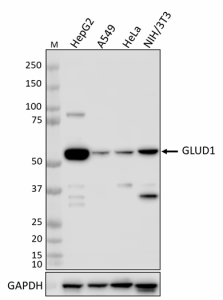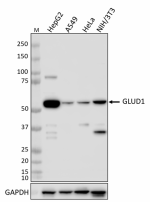- Clone
- W18177A (See other available formats)
- Regulatory Status
- RUO
- Other Names
- Glutamate Dehydrogenase 1, EC 1.4.1.3, GLUD, Epididymis Tissue Sperm Binding Protein Li 18mP, Epididymis Secretory Sperm Binding Protein, GDH 1
- Isotype
- Rat IgG2b, κ
- Ave. Rating
- Submit a Review
- Product Citations
- publications

-

Whole cell extracts (15 µg protein) from the indicated cell lines were resolved on a 4-12% Bis-Tris gel, transferred to PVDF and probed with 0.25 µg/mL (1:2000 dilution) of purified anti-GLUD1 antibody (clone W18177A) overnight at 4°C. Proteins were visualized by chemiluminescence detection using HRP Goat anti-rat IgG Antibody (Cat. No. 405405) at a 1:3000 dilution. Direct-Blot™ HRP anti-GAPDH Antibody (Cat. No. 607904) was used as a loading control at a 1:25000 dilution (lower). Lane M: Molecular weight marker. -

A549 cells were fixed with 4% paraformaldehyde for 10 minutes, permeabilized with methanol for 10 minutes, and blocked with 5% FBS for 60 minutes. Cells were then intracellularly stained with 1.0 µg/mL (1:500 dilution) of purified anti-GLUD1 antibody (clone W18177A, panel B) overnight at 4°C, followed by incubation with Alexa Fluor® 594 Goat anti-rat IgG Antibody (Cat. No. 405422) at 2.0 µg/mL and Alexa Fluor® 647 anti-Cytochrome c Antibody (Cat. No. 612310) at 2.0 µg/mL. Cytochrome C uses green pseudo-color for visualization (panel A). Nuclei were counterstained with DAPI, and the image was captured with a 60X objective.
| Cat # | Size | Price | Quantity Check Availability | Save | ||
|---|---|---|---|---|---|---|
| 933601 | 25 µg | 101 CHF | ||||
| 933602 | 100 µg | 253 CHF | ||||
Glutamate dehydrogenase (GLUD) is a mitochondrial enzyme involved in the reversible oxidative deamination of glutamate to ammonia and α-ketoglutarate (α-KG), which is a key intermediate in the tricarboxylic acid (TCA) cycle. α-KG is utilized to produce ATP, which in turn increases the ATP/ADP ratio and induces insulin secretion. GLUD mutations are associated with hyperinsulinism-hyperammonemia (HI/HA) syndrome. Humans have two isoenzymes, GLUD1 and GLUD2, each encoded by distinct genes. GLUD1 is widely expressed while GLUD2 is expressed in neural and testicular tissues.
Product DetailsProduct Details
- Verified Reactivity
- Human, Mouse
- Antibody Type
- Monoclonal
- Host Species
- Rat
- Immunogen
- Partial recombinant human GLUD1 protein
- Formulation
- Phosphate-buffered solution, pH 7.2, containing 0.09% sodium azide.
- Preparation
- The antibody was purified by affinity chromatography.
- Concentration
- 0.5 mg/mL
- Storage & Handling
- The antibody solution should be stored undiluted between 2°C and 8°C.
- Application
-
WB - Quality tested
ICC - Verified - Recommended Usage
-
Each lot of this antibody is quality control tested by Western blotting. For Western blotting, the suggested use of this reagent is 0.25 - 1.0 µg/mL. For immunocytochemistry, a concentration range of 1.0 - 5.0 μg/mL is recommended. It is recommended that the reagent be titrated for optimal performance for each application.
- Application Notes
-
This clone recognizes both human and mouse GLUD1.
Methanol permeabilization is recommended for ICC testing. Triton X-100 permeabilization showed weak signal. - RRID
-
AB_2820209 (BioLegend Cat. No. 933601)
AB_2820209 (BioLegend Cat. No. 933602)
Antigen Details
- Structure
- GLUD1 is a 558 amino acid protein with a predicted molecular weight of 61 kD.
- Distribution
-
Mitochondrial matrix/ubiquitously expressed
- Function
- Glutaminolysis
- Biology Area
- Cell Biology, Mitochondrial Function
- Molecular Family
- Enzymes and Regulators
- Antigen References
-
- Stanley CA, et al.1998. N Engl J Med. 338:1352-7
- Plaitakis A, et al. 2000. J Neurochem. 75:1862
- Yang C, et al. 2009. Cancer Res. 69:7986
- Jin L, et al. 2015. Cancer Cell. 27:257
- Gene ID
- 2746 View all products for this Gene ID
- UniProt
- View information about GLUD1 on UniProt.org
Related Pages & Pathways
Pages
Other Formats
View All GLUD1 Reagents Request Custom Conjugation| Description | Clone | Applications |
|---|---|---|
| Purified anti-GLUD1 | W18177A | WB,ICC |
Compare Data Across All Formats
This data display is provided for general comparisons between formats.
Your actual data may vary due to variations in samples, target cells, instruments and their settings, staining conditions, and other factors.
If you need assistance with selecting the best format contact our expert technical support team.
 Login / Register
Login / Register 









Follow Us